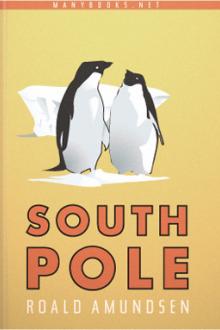The North Pole by Robert E. Peary (room on the broom read aloud .TXT) 📕

- Author: Robert E. Peary
- Performer: -
Book online «The North Pole by Robert E. Peary (room on the broom read aloud .TXT) 📕». Author Robert E. Peary
The preceding brief summary gives only an inadequate conception of the immense treasures of money and lives expended by the nations to explore the northern ice world and to attain the apex of the earth. All efforts to reach the Pole had failed, notwithstanding the unlimited sacrifice of gold and energy and blood which had been poured out without stint for nearly four centuries. But the sacrifice had not been without compensation. Those who had ventured their lives in the contest had not been actuated solely by the ambition to win a race—to breast the tape first—but to contribute, in Sir John Franklin's words, "to the extension of the bounds of science." The scores of expeditions, in addition to new geographical discoveries, had brought back a wealth of information about the animals and vegetable life, the winds and currents, deep sea temperatures, soundings, the magnetism of the earth, fossils and rock specimens, tidal data, etc., which have enriched many branches of science and greatly increased the sum of human knowledge.
A brief summer excursion to Greenland in 1886 aroused Robert E. Peary, a civil engineer in the United States Navy, to an interest in the polar problem. Peary a few years previously had been graduated from Bowdoin College second in his class, a position which means unusual mental vigor in an institution which is noted for the fine scholarship and intellect of its alumni. He realized at once that the goal which had eluded so many hundreds of ambitious and dauntless men could be won only by a new method of attack.
The first arctic problem with which Peary grappled was considered at that time in importance second only to the conquest of the Pole; namely, to determine the insularity of Greenland and the extent of its projection northward. At the very beginning of his first expedition to Greenland, in 1891, he suffered an accident which sorely taxed his patience as well as his body, and which is mentioned here as it illustrates the grit and stamina of his moral and physical make-up. As his ship, the Kite, was working its way through the ice fields off the Greenland shore, a cake of ice became wedged in the rudder, causing the wheel to reverse. One of the spokes jammed Peary's leg against the casement, making it impossible to extricate himself until both bones of the leg were broken. The party urged him to return to the United States for the winter and to resume his exploration the following year. But Peary insisted on being landed as originally planned at McCormick Bay, stating that the money of his friends had been invested in the project and that he must "make good" to them. The assiduous nursing of Mrs. Peary, aided by the bracing air, so speedily restored his strength that at the ensuing Christmas festivities which he arranged for the Eskimos, he out-raced on snowshoes all the natives and his own men!
In the following May, with one companion, Astrup, he ascended to the summit of the great ice cap which covers the interior of Greenland, 5000 to 8000 feet in elevation, and pushed northward for 500 miles over a region where the foot of man had never trod before, in temperatures ranging from 10° to 50° below zero, to Independence Bay, which he discovered and named, July 4, 1892. Imagine his surprise on descending from the tableland to enter a little valley radiant with gorgeous flowers and alive with murmuring bees, where musk oxen were lazily browsing.
This sledding journey, which he duplicated by another equally remarkable crossing of the ice cap three years later, defined the northern extension of Greenland and conclusively proved that it is an island instead of a continent extending to the Pole. In boldness of conception and brilliancy of results these two crossings of Greenland are unsurpassed in arctic history. The magnitude of Peary's feat is better appreciated when it is recalled that Nansen's historic crossing of the island was below the Arctic Circle, 1000 miles south of Peary's latitude, where Greenland is some 250 miles wide.
Peary now turned his attention to the Pole, which lay 396 geographical miles farther north than any man had penetrated on the western hemisphere. To get there by the American route he must break a virgin trail every mile north from Greely's 83° 24´. No one had pioneered so great a distance northward. Markham and others had attained enduring fame by advancing the flag considerably less than 100 miles, Parry had pioneered 150 miles, and Nansen 128 from his ship.
His experiences in Greenland had convinced Peary, if possible more firmly than before, that the only way of surmounting this last and most formidable barrier was to adopt the manner of life, the food, the snowhouses, and the clothing of the Eskimos, who by centuries of experience had learned the most effective method of combating the rigors of arctic weather; to utilize the game of the northland, the arctic reindeer, musk ox, etc., which his explorations had proved comparatively abundant, thus with fresh meat keeping his men fit and good-tempered through the depressing winter night; and lastly to train the Eskimo to become his sledging crew.
In his first north polar expedition, which lasted for four years, 1898-1902, Peary failed to get nearer than 343 miles to the Pole. Each successive year dense packs of ice blocked the passage to the polar ocean, compelling him to make his base approximately 700 miles from the Pole, or 200 miles south of the headquarters of Nares, too great a distance from the Pole to be overcome in one short season. During this trying period, by sledging feats which in distance and physical obstacles overcome exceeded the extraordinary records made in Greenland, he explored and mapped hundreds of miles of coast line of Greenland and of the islands west and north of Greenland.
On the next attempt, Peary insured reaching the polar ocean by designing and constructing the Roosevelt, whose resistless frame crushed its way to the desired haven on the shores of the polar sea. From here he made that wonderful march of 1906 to 87° 6´, a new world's record. Winds of unusual fury, by opening big leads, robbed him of the Pole and nearly of his life.
The story of the last Peary expedition, which resulted in the discovery of the Pole and of the deep ocean surrounding it, is told in the present volume by Commander Peary. The 396 miles from Greely's farthest had been vanquished as follows: 1900, 30 miles; 1902, 23 miles; 1906, 169 miles; 1909, 174 miles.
No better proof of the minute care with which every campaign was prearranged can be given than the fact that, though Peary has taken hundreds of men north with him on his various expeditions, he has brought them all back, and in good health, with the exception of two, who lost their lives in accidents for which the leader was in no wise responsible. What a contrast this record is to the long list of fatalities from disease, frost, shipwreck, and starvation which in the popular mind has made the word arctic synonymous with tragedy and death.
Thus Robert E. Peary has crowned a life devoted to the exploration of the icy north and to the advancement of science by the hard-won discovery of the North Pole. The prize of four centuries of striving yielded at last to the most persistent and scientific attack ever waged against it. Peary's success was made possible by long experience, which gave him a thorough knowledge of the difficulties to be overcome, and by an unusual combination of mental and physical power—a resourcefulness which enabled him to find a way to surmount all obstacles, a tenacity and courage which knew no defeat, and a physical endowment such as nature gives to few men.
It has been well said that the glory of Peary's achievement belongs to the world and is shared by all mankind. But we, his fellow-countrymen, who have known how he has struggled these many years against discouragement and scoffing and how he has persevered under financial burdens that would have crushed less stalwart shoulders, specially rejoice that he has "made good at last," and that an American has become the peer of Hudson, Magellan, and Columbus.
National Geographic Society,
Washington, D. C., U. S. A.
August 30, 1910.
It may not be inapt to liken the attainment of the North Pole to the winning of a game of chess, in which all the various moves leading to a favorable conclusion had been planned in advance, long before the actual game began. It was an old game for me—a game which I had been playing for twenty-three years, with varying fortunes. Always, it is true, I had been beaten, but with every defeat came fresh knowledge of the game, its intricacies, its difficulties, its subtleties, and with every fresh attempt success came a trifle nearer; what had before appeared either impossible, or, at the best, extremely dubious, began to take on an aspect of possibility, and, at last, even of probability. Every defeat was analyzed as to its causes in all their bearings, until it became possible to believe that those causes could in future be guarded against and that, with a fair amount of good fortune, the losing game of nearly a quarter of a century could be turned into one final, complete success.
It is true that with this conclusion many well informed and intelligent persons saw fit to differ. But many others shared my views and gave without stint their sympathy and their help, and now, in the end, one of my greatest unalloyed pleasures is to know that their confidence, subjected as it was to many trials, was not misplaced, that their trust, their belief in me and in the mission to which the best years of my life have been given, have been abundantly justified.
But while it is true that so far as plan and method are concerned the discovery of the North Pole may fairly be likened to a game of chess, there is, of course, this obvious difference: in chess, brains are matched against brains. In the quest of the Pole it was a struggle of human brains and persistence against the blind, brute forces of the elements of primeval matter, acting often under laws and impulses almost unknown or but little understood by us, and thus many times seemingly capricious, freaky, not to be foretold with any degree of certainty. For this reason, while it was possible to plan, before the hour of sailing from New York, the principal moves of the attack upon the frozen North, it was not possible to anticipate all of the moves of the adversary. Had this been possible, my expedition of 1905-1906, which established the then "farthest north" record of 87° 6´, would have reached the Pole. But everybody familiar with the records of that expedition knows that its complete success was frustrated by one of those unforeseen





Comments (0)